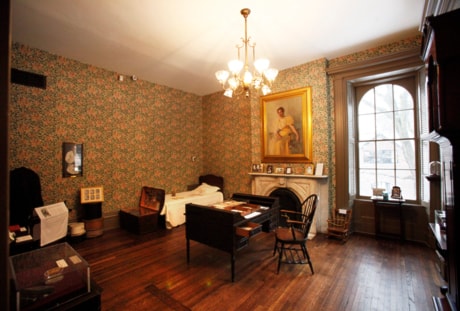CHICAGO — At the turn of the 20th century, thousands of immigrants sought out Jane Addams’ Hull House in Chicago.
There they received medical treatment at settlement house clinics, learned job skills through training classes and found community at an art gallery, gymnasium and gardening club.
The stories of Addams and the immigrants are told at the Jane Addams Hull-House Museum, which in December finished a major renovation following the 150th anniversary of Addams’ birth last fall.
Visitors can now see new exhibits, walk into Addams’ restored bedroom and view two sides of the famous feminist social reformer’s life — her Nobel Peace Prize and the hundreds of pages of her FBI file.
Hull House was the most well-known of the 400 settlement houses in the United States in the early 1900s.
The settlements were designed to provide services to immigrants and the poor while uplifting them through culture, education and recreation.
The legacy of Hull House remains relevant today, said Victoria Brown, a history professor at Grinnell College in Iowa and author of “The Education of Jane Addams.”
“We’re in a time right now of people kind of realizing that they need to work locally and they need to work with fellow citizens in their community across class and across race,” Brown said.
“That was certainly core to her convictions.”
Hull House, now a National Historic Landmark, was built as a country estate by Charles Hull in 1856.
Addams started renting the property in 1889. At its peak, Hull House served more than 9,000 people a week, offering medical help, an art gallery, citizenship classes, a gardening club and a gym with sports programs.
In the 1960s, there were plans to tear down the entire settlement to build what is now the University of Illinois-Chicago campus.
Eventually two of the original 13 buildings were preserved and have housed the museum since 1967.
The Hull House Association social service group still exists but it has been decentralized throughout Chicago.
The museum belongs to UIC’s College of Architecture and Arts.
The latest renovation started more than a year ago with US$800,000 in grant money. Museum-goers can now walk up a curved wooden staircase to stand in Addams’ bedroom with its wallpaper of pink flowers and green leaves.
Her 1931 gold Nobel medal is in a glass case next to a clipboard that keeps her long FBI file together for visitors to flip through.
Along one wall is a small twin bed with white embroidered linens and a black silk dress. Across the room, her 1881 diploma and class ring from Rockford Female Seminary are displayed.
Museum curators approached the renovation wanting to tell the many stories of Jane Addams and the immigrants who came to Hull House, said museum director Lisa Yun Lee.
“There’s actually more than one story about Jane Addams,” Lee said. “That’s why we placed the Nobel Peace Prize next to her FBI file.”
Addams’ writing desk is in the centre of her bedroom, the top filled with copies of letters she wrote and received.
“The workers in the garment industry will forever remember your splendid aid in their efforts to abolish the sweat shop,” read one Western Union telegram to Addams from the president of the International Ladies Garment Workers Union for her 70th birthday in 1930.
Hull House’s reputation has persevered because of Addams’ skilled and prolific writing.
“She was out there writing magazine articles, giving speeches, publishing books,” Brown said. “That meant her voice was widely heard in the U.S. She was the premiere networker. She was brilliant at it.”
Museum curators hope to be experiential in their approach as well.
Downstairs, visitors pass a velvet purple curtain into an empty octagon-shaped room where sounds from the era play: horse clops, typewriters, old telephone rings, a bicycle bell and a train.
Curators also take advantage of modern technology. Throughout the museum, visitors can use their cellphones to call a special phone number and hear commentary and discussion about exhibits from figures like the late Studs Terkel and retired UIC professor and former 1960s radical Bill Ayers.
Although it’s primarily a place to teach the public about Hull House’s history, the museum also functions as part of the community. It sponsors urban farm tours, free soup lunches with social justice discussions and documentary film series.
Visitors can find inspiration in the museum’s small rooms that became home to an important and influential movement, Brown said.
“Just seeing those rooms would give you a sense that very, very famous things often start from small beginnings,” Brown said. “Any of us starting with an idea . if you have faith in it and you nurture it, it can grow.”
———
If You Go.
JANE ADDAMS HULL HOUSE MUSEUM: 800 S. Halsted St., Chicago, http://www.uic.edu/jaddams/hull/ or 312-413-5353. Open Tuesday- Friday, 10 a.m.- 4 p.m.; Sundays noon-4 p.m.. Closed Saturdays and Mondays. Public tours are offered at 1 p.m. on Wednesdays and Sundays. Admission is free.
———
Online:
http://www.uic.edu/jaddams/hull/
